

Formative assessment. Assessment Design: A Matrix To Assess Your Assessments. 30+ Formative Assessment Strategies. Formative assessment was brought to the educational forefront by Paul Black and Dylan William in 1998 when they conducted a meta-analysis on formative assessment (Popham, 2008).
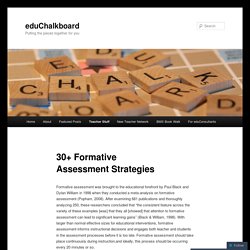
After examining 681 publications and thoroughly analyzing 250, these researchers concluded that “the consistent feature across the variety of these examples [was] that they all [showed] that attention to formative assessment can lead to significant learning gains” (Black & William, 1998). With larger than normal effective sizes for educational interventions, formative assessment informs instructional decisions and engages both teacher and students in the assessment processes before it is too late. Formative assessment should take place continuously during instruction,and ideally, this process should be occurring every 20 minutes or so. Www.trianglehighfive.org/pdf/009_Formative_Assessment_Ideas.pdf. Www.trianglehighfive.org/pdf/009_Formative_Assessment_Ideas.pdf. Www.isbe.net/common_core/pdf/da-form-asmt-chart.pdf. The Importance of Classroom Discussion.
Discussion. Formative Assessment Ideas. Modifying the Flipped Classroom: The "In-Class" Version. So.

Alternatives To Homework: A Chart For Teachers. Alternatives To Homework: A Chart For Teachers Part of rethinking learning means rethinking the bits and pieces of the learning process–teaching strategies, writing pieces, etc.
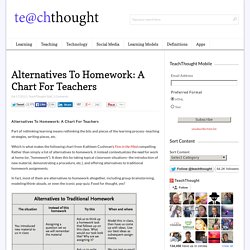
Which is what makes the following chart from Kathleen Cushman’s Fires in the Mind compelling. Rather than simply a list of alternatives to homework, it instead contextualizes the need for work at home (or, “homework”). It does this by taking typical classroom situations–the introduction of new material, demonstrating a procedure, etc.), and offering alternatives to traditional homework assignments. Self-Evaluation. Self-Evaluation In order to become lifelong learners, students need to learn the importance of self-evaluation.
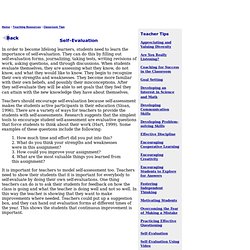
They can do this by filling out self-evaluation forms, journalizing, taking tests, writing revisions of work, asking questions, and through discussions. When students evaluate themselves, they are assessing what they know, do not know, and what they would like to know. They begin to recognize their own strengths and weaknesses. They become more familiar with their own beliefs, and possibly their misconceptions. Självutvärdering Använda video. Self-evaluation is a very important learning method and teachers should encourage students to use it as a lifelong learning tool.
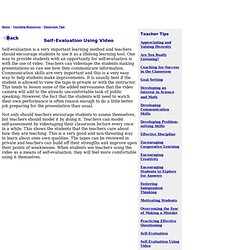
One way to provide students with an opportunity for self-evaluation is with the use of video. Teachers can videotape the students making presentations so can see how they communicate information. Communication skills are very important and this is a very easy way to help students make improvements. It is usually best if the student is allowed to view the tape in private or with the instructor. This tends to lesson some of the added nervousness that the video camera will add to the already uncomfortable task of public speaking. The Lab. Formativ bedömning med digitala hjälpmedel - en handfast föreläsning av Katarina Lycken Rüter - Stockholmskällan. Aland72: @MichaelRystad En tweet från... The Best Questions To Use For Class Closing Activities — What Are Yours? (NOTE: This post was not originally a “Best…” list — it was one where I shared some of my ideas and invited readers to share their own.

Since that time, a number of readers have contributed suggestions, so I’ve revised it to include their ideas, which can be found in the second half of the the post) 10 Assessments You Can Perform In 90 Seconds. Good assessment is frequent assessment.
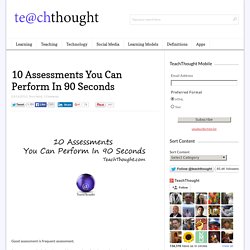
Any assessment is designed to provide a snapshot of student understand—the more snapshots, the more complete the full picture of knowledge. On its best day, an assessment will be 100% effective, telling you exactly what a student understands. More commonly, the return will be significantly lower as the wording of questions, the student’s sense of self-efficacy, or other factors diminish their assessment performance. It sounds obvious, but a student is a human being with an entire universe of personal problems, distraction, and related challenges in recalling the information in the form the assessment demands.
Home of free rubric tools. Welcome to iRubric iRubric is a comprehensive rubric development, assessment, and sharing tool.
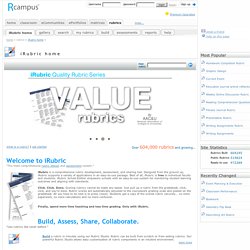
Designed from the ground up, iRubric supports a variety of applications in an easy-to-use package. Best of all, iRubric is free to individual faculty and students. iRubric School-Edition empowers schools with an easy-to-use system for monitoring student learning outcomes and aligning with standards. Click. Click. Finally, spend more time teaching and less time grading. How to Get Started With InfuseLearning. Why Formative Assessments Matter. Summative assessments, or high stakes tests and projects, are what the eagle eye of our profession is fixated on right now, so teachers often find themselves in the tough position of racing, racing, racing through curriculum.

But what about informal or formative assessments? Are we putting enough effort into these? What Are They? Informal, or formative assessments are about checking for understanding in an effective way in order to guide instruction. They are used during instruction rather than at the end of a unit or course of study. What this means is that if we are about getting to the end, we may lose our audience, the students. Formative assessment: implications for classroom practice. Collaboration - Formative_Assessment_Examples_2008.pdf. Persuasion Map. Compare Contrast Map. Think, Pair, Share. What is Think, Pair, Share?
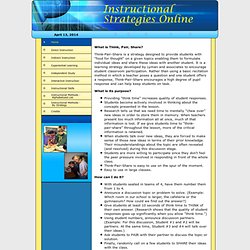
Think-Pair-Share is a strategy designed to provide students with "food for thought" on a given topics enabling them to formulate individual ideas and share these ideas with another student. It is a learning strategy developed by Lyman and associates to encourage student classroom participation. Rather than using a basic recitation method in which a teacher poses a question and one student offers a response, Think-Pair-Share encourages a high degree of pupil response and can help keep students on task. You Probably Misunderstand Feedback For Learning. By Grant Wiggins Editor’s Note: The title was written by me, not Grant. ; ^ ) Who could argue with the idea that formative assessment is a good thing? Both common sense and the research make clear that more feedback and opportunities to use it enhances performance and achievement [(See Pollock (2012), Hattie (2008) and Marzano, Pickering & Pollock (2001)]; I argued this point thoroughly 14 years ago (Wiggins 1998).
Yet, even Hattie acknowledges that in spite of the fact that his research long ago clearly revealed that “feedback was among the most powerful influences on achievement [Hattie (2008), p. 173] he has “struggled to understand the concept ever since.” 10 Assessments You Can Perform In 90 Seconds. 35 Uses for Post It Notes in the Classroom. Models speak louder than words. Alexis Wiggins [licensed for non-commercial use only] / Alexis Wiggins's Wiki. Classroom Instruction That Works. Five Steps to Create a Progressive, Student-Centered Classroom. By Mark Barnes A student-centered classroom is built on autonomy and the elimination of traditional teaching practices. The student-centered classroom operates on collaboration, project-based learning, technology integration, and plenty of conversation between students and teachers about learning.
Here are five steps to building a remarkable student-centered classroom. 1. Create ongoing projects. 2. 3. 4. 5.
Using Peer Review to Help Students Improve Their Writing. Educational Technology and Mobile Learning: flipped classroom. Commons:FLIP. Synligt lärande lucka 17. Exempel på några bedömningstekniker som tydliggör mål och kunskapskrav.